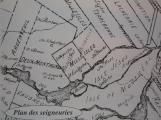2
Under the seigneurial regimeIn 1664, a royal decree established the Coutume de Paris as the sole and unique judicial system in New France. Faced with the failure of companies to populate the new colony, King Louis XIV, through Colbert, his Minister responsible for the colonies, established as early as 1665, a new mode of landholding known as the seigneurial regime. Through the Governor or the Intendant, the King conceded a large stretch of land to a seigneur (a military officer, a nobleman or a religious community) on the condition that the seigneur had colonists come establish and develop the seigneurie.
The first section of the Coutume of the Provost and Vicomte of Paris in 1580 concerned mechanisms that defined and governed the rights and duties of the dominating seigneur and the obligations of the ?censitaires? (the ?censals,? or the people included in the census). In each seigneurie, a "seigneurial" court saw to it that the rights of both parties were respected.
The seigneurial regime allowed regular and harmonious development as it extended colonization continuously along both banks of the Saint Lawrence. Consequently, it created a succession of villages spread out mainly between Quebec City and Montreal.
On the local level, which is to say inside a seigneurie, the development plan generally evolved according to the following model: after surveying the entire seigneurie, the seigneur began by first conceding land around the periphery before conceding lots in the territory reserved for the village.
From 1825 on, the colonists complained increasingly about the heavy charges established by the seigneuries. In 1834, when the Chambre d'Assemblée adopted the 92 Resolutions, the abolishment of the seigneurial regime was outlined, and the seigneurs, who all supported the government, were strongly denounced. The seigneurial regime was finally abolished in December 1854, and was replaced by a new administrative entity: the municipality.
